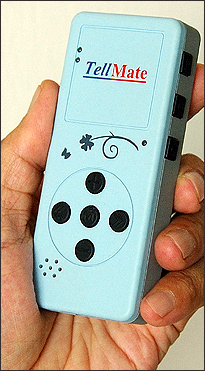Aug 17, 2007The Braille system has become a ubiquitous tool for enabling the blind to read and write. However, S.J. Chin, founder of Singapore-based GaiShan Technology, thinks RFID could become a much richer, more powerful tool for those with visual impairments. Chin has completed development of a system called TellMate, which employs passive RFID tags to help the blind identify objects they use in their daily lives but have difficulty recognizing, such as credit cards inside a wallet.
Some testers in Asia, Chin says, are using TellMate to help select which payment cards to pull from their wallets when paying for goods. Another tester, a massage therapist, is using the system as an occupational aid, with RFID labels attached to select bottles of scented massage oil, based on her client's preferences.

The TellMate system uses 13.56 MHz ISO 15693-compliant tags. GaiShan sources these tags from NXP Semiconductors, working with Vanskee, an RFID converter in Singapore, to build the inlays into long-lasting paper or plastic labels with strong but reusable adhesive backings. The tags can be attached to objects, Chin says, then removed from those objects and placed onto others. The labels come in a variety of sizes.
Chin worked with SkyeTek, a Boulder, Colo., designer of RFID modules, to embed SkyeTek's ISO 15693-compliant reader into the TellMate handheld computer. The company also helped Chin develop the software application used to commission and read the tags.
The TellMate has three main RFID function buttons: one for recording a description of an object to which a tag is attached, one to play that recording and one to stop the playback. To identity an object—a credit card, for instance—a user would attach an RFID label to it, hold the handheld reader within 2 centimeters of the label, press the record button and speak a description of the object into the handheld.
Chin says users can record anything they'd like regarding an object. For instance, a user might record the card's issuing bank, its expiration date or its account number. To later identity that object, the user would hold the handheld within a couple centimeters of the object's tag (located via touch), then press the play button to hear the recording associated with the tag. Headphones can be used to keep the information from being broadcast aloud. The stop button can be pressed at any time during a recording if the user opts not to hear the full recording.
"The whole idea behind the system is to enable the blind users to be as independent as possible," says Chin. He first conceived of the TellMate system, and decided to create GaiShan Technology, after working as an engineering consultant on an RFID-based industrial laundry application. There, tags were used to identity individual garments and link personnel to a usage history for each garment, and Chin realized they could be used to link much more information than would be possible through the use of Braille symbols.
Chin sees great potential in the TellMate as a tool for educating the blind. "Say that you have a map of the United States, and the name of each state is printed in Braille [at each state location]," he explains. "You could also add a tag to the map, so that a student would use Braille to identify the state, and then use the TellMate to read the tag and learn more information about that state, such as its population, or major cities, etc."
Chin plans to sell the TellMate system through retailers specializing in equipment for the blind in Asia, Europe and the United States. He says the system has been tested not only in Singapore, but also in other parts of Asia, as well as in the United States and Europe. Demand for the system has spread through a podcast, which one of the early testers created and posted on Web sites used by organizations for the blind on all three continents. Chin expects the system to become commercially available soon, retailing in the United States for roughly $500.
Other RFID-based systems have been developed around the world as aides for the blind. Chen says that what sets TellMate apart is that the handset is designed not just as a reader, but also as a more complete information system. The device includes a fully functional MP3 player and FM radio, and can be used to store voice recordings not related to specific tags. This last function enables users to keep a digital notebook of lists, observances and reminders. The device also offers a function that announces the time and date.
Awarea, a Seattle-based startup, launched an RFID system in downtown Seattle designed to trigger audio announcements on a range of topics, such as sales offered by local merchants and a bus's exact arrival time at a certain stop. The system was tested by a number of blind residents (see RFID Brings Messages to Seattle Sidewalks). Additionally, a researcher at Utah State University has developed an RFID-controlled robot designed to guide the blind through airports and other hard-to-navigate areas (see The Seeing-Eye Robot).

